RED-SIDED GARTER SNAKE MORTALITY ON PTH#17 AT NARCISSE WMA
INTRODUCTION
The Narcisse Snake Den Area is renowned internationally as a unique natural phenomenon
representing the world's largest concentration of snakes. In fact, these aggregations
represent one of the largest concentrations of any vertebrate species anywhere in the world.
Public viewing of spring and fall concentrations of snakes around the dens sites has reached
approximately 20,000 visitors annually.
Government, local advocacy groups and the public have become increasingly concerned about
the levels of snake mortality occurring on Provincial Trunk Highway (PTH) #17, adjacent to the
Narcisse Snake Den Area. Daily monitoring conducted on PTH # 17 from spring 1991 to fall 1993
revealed mortality levels at times approaching 10,000 animals, primarily during the fall
season.
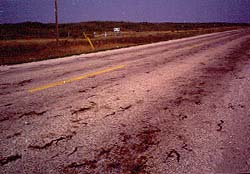 |
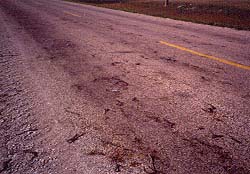 |
| Red-sided garter snakes killed on the highway |
The dynamic nature of the Narcisse snake population would suggest that recruitment is very
high (Gregory, pers. comm.), however, the long term impact of this annual highway mortality is
unknown.Any potential long term population decline is of special concern, especially as it
relates to the area's ability to sustain its present world renowned viewing opportunity.
Amphibian and reptile mortality on roads is a phenomenon known to exist elsewhere in the
world. In his Natural Resources Management thesis "Evaluation of Methods to Reduce Road
Mortality of Red-sided Gartersnakes at Narcisse Wildlife Management Area", Joshua Chan
detailed some of these instances and described techniques that have been used to mitigate this
mortality. Chan discussed various snake behaviours that relate directly to this problem, such
as pheromone trail laying, wall following, and thermal attraction. Chan experimented with the
use of snake pheromone as a "chemical fencing", expanded drift fencing at the existing tunnel
system and introduced a heat gradient to the tunnel to make it more attractive to migrating
snakes. After 2 seasons of monitoring snake activity at the tunnel Chan found some evidence
that the drift fencing successfully directs snakes to the tunnel entrance, and that some
snakes will travel through the tunnel. However, he found that many animals preferred to bask
at the warmer entrance to the tunnel. The chemical fence experiment was inconclusive because
of a lack of snakes migrating through the area at the time. Other mitigative measures, such as
road closure, human carry over and various traps were not tested because these techniques were
considered unfeasible at the time.
REGIONAL MONITORING PROJECT
During spring 1994 the drift fence on the east side of PTH#17 was expanded to approximately
500 meters to enhance the interception of snakes migrating west to marshes and sloughs in
Narcisse WMA. Wooden fencing, approximately 30cm. (12in.) high was installed to test snake
response to a much lower barrier than normally used. A rudimentary heat gradient was created
by the placement of a propane heater at the outlet of the tunnel. Unfortunately a lack of
power at this site precluded the use of a more efficient heating system.
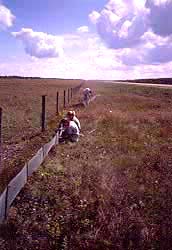 |
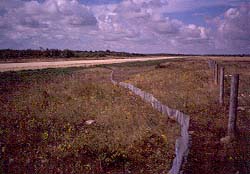 |
| Fencing designed to guide garter snakes to a snake tunnel in Manitoba
|
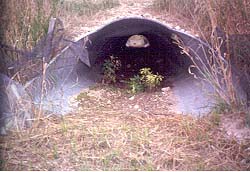
The snake tunnel |
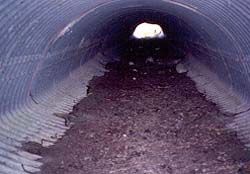
Close up of the snake tunnel |
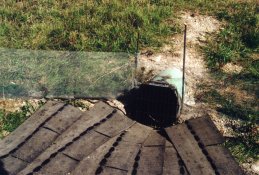
|
Staff spent each afternoon during the spring season monitoring snake response to the two
types of drift fencing and the tunnel system. Unfortunately, less than 100 snakes were
observed in the area of the drift fencing and tunnel system during this period. Snakes that
were intercepted by the lower drift fence displayed a strong wall following behaviour,
travelling toward the tunnel rather than climbing over the fence. Snakes that reached the
tunnel displayed similar tendencies observed by Chan; some snakes travelled through the
tunnel, especially during periods when the heating system was operating, and some basked at
the entrance.
During fall 1994 the drift fencing on the west side of PTH#17 was expanded to approximately
500 meters to enhance the interception of snakes migrating east to the hibernacula in the
Narcisse Snake Den Area. New tunnel system material was purchased and placed along the drift
fence to simulate its installation at the road surface. This new system consisted of a 20cm.
polymer concrete channel covered by a slotted iron grate that would allow heat and light to
enter the tunnel, thus equalising the internal and external environments. As in the spring,
monitoring identified that some snakes responded positively to the drift fencing and both
tunnel systems. To supplement observations, snakes were collected at the den sites, released
around the 2 tunnel systems and observed. Snakes readily entered and travelled through the new
channel and grate system, suggesting that tunnel environment may be a critical factor in
developing a successful mitigation technique. While channel and grate system could be
installed at the road surface requiring less construction work and disturbance of the road
bed, Department of Highways staff have since looked at this system and expressed strong
reservations with the long term feasibility of using any material installed at the road
surface.
Since 1995 the drift fence on the west side of the PTH#17 has been expanded to cover
approximately 1/2 the migratory corridor. Maintenance of the existing drift fence and
replacement of damaged portions has occurred annually, however, no additional funds have been
allocated for the further expansion of the drift fence. Fall snake mortality and movement
monitoring has been sporadic and dependent on the availability of seasonal staff and
volunteers.
The level of snake mortality on PTH#17 during the fall 1998 and fall 1999 seasons appeared
to be especially high. It has been suggested that this increased mortality may have been the
result of a very high snake population, as well as the possibility that snakes are migrating
west from the dens back over the highway.
NARCISSE SNAKE MORTALITY ADVISORY GROUP
A Narcisse Snake Mortality Advisory Group, consisting of government representatives, local
government and advocacy groups, and the scientific community, has been formed to study the
problem and develop a plan to deal with it in an effective and feasible manner. The direct
involvement of the public and non-government representatives in the advisory group may provide
a broader perspective on the problem and uncover new partnership or funding opportunities.
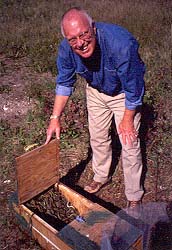 |
On the recommendation of the Advisory Group, a number of experiments were conducted during
the fall 1999 season. Pitfall and box traps were set up along the drift fence and at the exit
of the tunnel to quantify the level of snake use occurring at these locations. A total of
10,927 snakes (15% of the estimated population) were caught in the traps, suggesting that
these techniques are effective in directing snakes to the tunnel and under the road. The
installation of various sized culverts and monitoring of their use by snakes may suggest that
an efficient, cost-effective system is possible. |
| In addition, snake crossing – speed
reduction signs were installed at the north and south ends of the migratory corridor to alert
the public to the need to reduce speed in this portion of the highway. Monitoring of snake
response to the reduced speed identified that animals crossing the highway can avoid being hit
by cars travelling at a slower speed. Unfortunately, most motorists did not heed the speed
reduction request and as a result the benefits of this technique were minimal. The signs will
continue to be installed during migratory periods to make the motoring public aware of the
need to reduce speed through the corridor. |
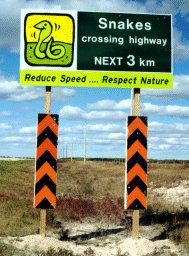 |
SNAKE TUNNEL PROJECT
The Narcisse Snake Mortality Advisory Group was approached by Manitoba Hydro to develop and
implement an experimental project to reduce snake mortality by creating a number of snake
tunnels under PTH#17 using the Corporation's horizontal boring equipment. The Manitoba Hydro
Construction Section is capable of boring and installing pipes up to a maximum 40 cm. (16 in.)
diameter.
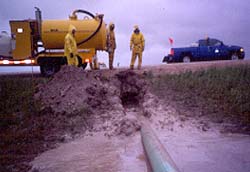 |
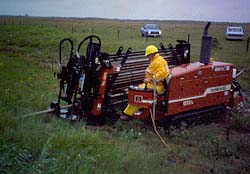 |
| Construction of a snake tunnel |
In June and September 2000 Manitoba Hydro successfully installed 4 pipes ranging from 6
inches to 12 inches in size. Drift fences have been erected to direct snakes to these new
tunnels.The effectiveness of the smaller sized pipes as a snake tunnel will be monitored by
capturing and counting snakes as they travel through the pipe, as well as observing snake
behaviour adjacent to and in the pipes. If these new tunnels proves to be effective, the
installation of a series of smaller sized pipes, using the horizontal drilling technique,
could significantly reduce or eliminate the snake mortality problem on PTH#17. In addition, it
would be significantly more cost effective and far less intrusive than installing standard
sized culverts
Contact:Dave Roberts
Wildlife Technician
Manitoba Conservation
Gimli, Manitoba
Phone: (204)642-6078
E-mail:
Updated: May 6, 2008
| 
